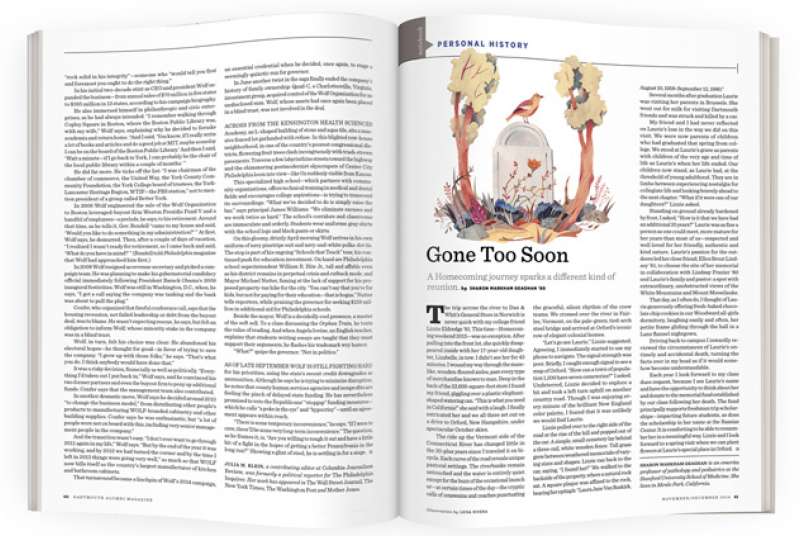
Gone Too Soon
The trip across the river to Dan & Whit’s General Store in Norwich is never quick with my college friend Lizzie Eldredge ’81. This time—Homecoming weekend 2015—was no exception. After pulling into the front lot, she quickly disappeared inside with her 17-year-old daughter, Lizabelle, in tow. I didn’t see her for 45 minutes. I wound my way through the maze-like, wooden-floored aisles, past every type of merchandise known to man. Deep in the back of the 22,600-square-foot store I found my friend, giggling over a plastic elephant-shaped watering can. “This is what you need in California!” she said with a laugh. I finally extricated her and we all three set out on a drive to Orford, New Hampshire, under spectacular October skies.
The ride up the Vermont side of the Connecticut River has changed little in the 30-plus years since I traveled it on bicycle. Each curve of the road reveals unique pastoral settings. The riverbanks remain untouched and the water is entirely quiet except for the buzz of the occasional launch or—at certain times of the day—the cryptic calls of coxswains and coaches punctuating the graceful, silent rhythm of the crew teams. We crossed over the river in Fairlee, Vermont, on the pale-green, tied-arch steel bridge and arrived at Orford’s iconic row of elegant colonial homes.
“Let’s go see Laurie,” Lizzie suggested. Agreeing, I immediately started to use my phone to navigate. The signal strength was poor. Briefly, I caught enough signal to see a map of Orford. “How can a town of population 1,200 have seven cemeteries?” I asked. Undeterred, Lizzie decided to explore a bit and took a left turn uphill on another country road. Though I was enjoying every minute of the brilliant New England color palette, I feared that it was unlikely we would find Laurie.
Lizzie pulled over to the right side of the road at the rise of the hill and popped out of the car. A simple, small cemetery lay behind a three-rail, white wooden fence. Tall grass grew between weathered memorials of varying sizes and shapes. Lizzie ran back to the car, saying, “I found her!” We walked to the backside of the property, where a natural rock sat. A square plaque was affixed to the rock, bearing her epitaph: “Laura Jane Van Buskirk, August 10, 1958-September 12, 1980.”
Several months after graduation Laurie was visiting her parents in Brussels. She went out for milk for visiting Dartmouth friends and was struck and killed by a car.
My friend and I had never reflected on Laurie’s loss in the way we did on this visit. We were now parents of children who had graduated that spring from college. We stood at Laurie’s grave as parents with children of the very age and time of life as Laurie’s when her life ended. Our children now stand, as Laurie had, at the threshold of young adulthood. They are in limbo between experiencing nostalgia for collegiate life and looking bravely ahead to the next chapter. “What if it were one of our daughters?” Lizzie asked.
Standing on ground already hardened by frost, I asked, “How is it that we have had an additional 35 years?” Laurie was as fine a person as one could meet, more mature for her years than most of us—respected and well loved for her friendly, authentic and kind nature. Laurie’s passion for the outdoors led her close friend, Ellen Brout Lindsey ’81, to choose the site of her memorial in collaboration with Lindsay Frazier ’80 and Laurie’s family and pastor: a spot with extraordinary, unobstructed views of the White Mountains and Mount Moosilauke.
That day, as I often do, I thought of Laurie generously offering fresh-baked chocolate chip cookies in our Woodward all-girls dormitory, laughing easily and often, her petite frame gliding through the hall in a Lanz flannel nightgown.
Driving back to campus I inwardly reviewed the circumstances of Laurie’s untimely and accidental death, turning the facts over in my head as if it would somehow become understandable.
Each year I look forward to my class dues request, because I see Laurie’s name and have the opportunity to think about her and donate to the memorial fund established by our class following her death. The fund principally supports freshman trip scholarships—impacting future students, as does the scholarship in her name at the Rassias Center. It is comforting to be able to remember her in a meaningful way. Lizzie and I look forward to a spring visit when we can plant flowers at Laurie’s special place in Orford.
Sharon Markham Geaghan is an emerita professor of pathology and pediatrics at the Stanford University School of Medicine. She lives in Menlo Park, California.










